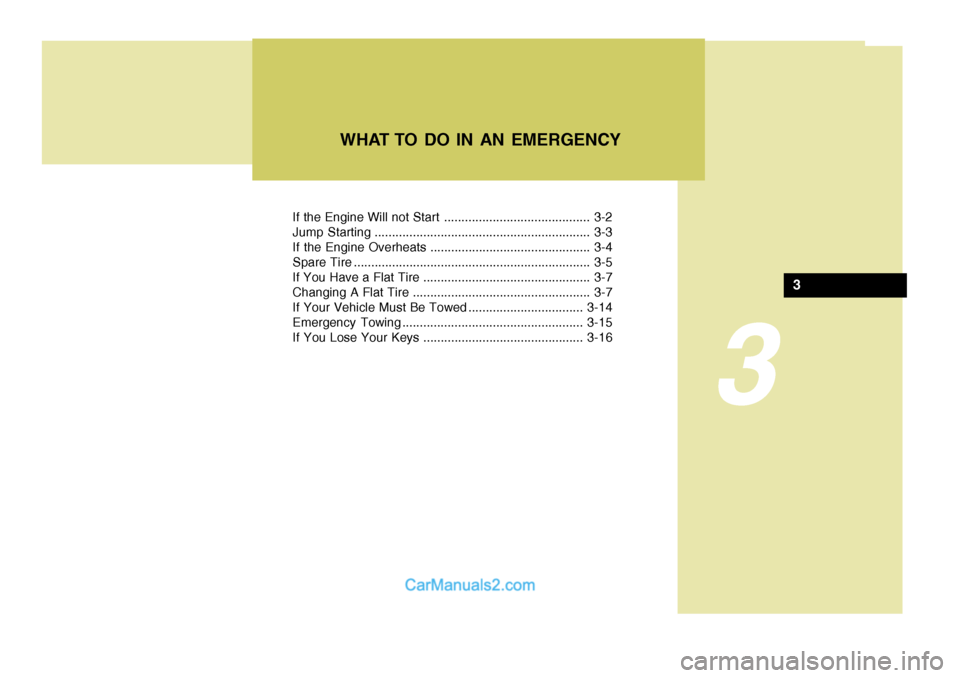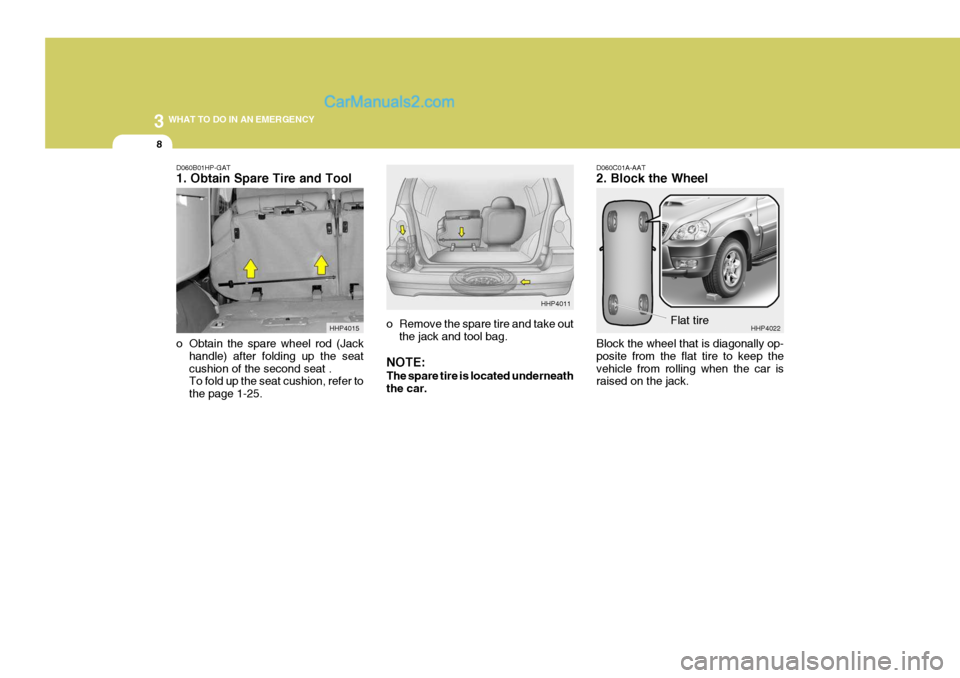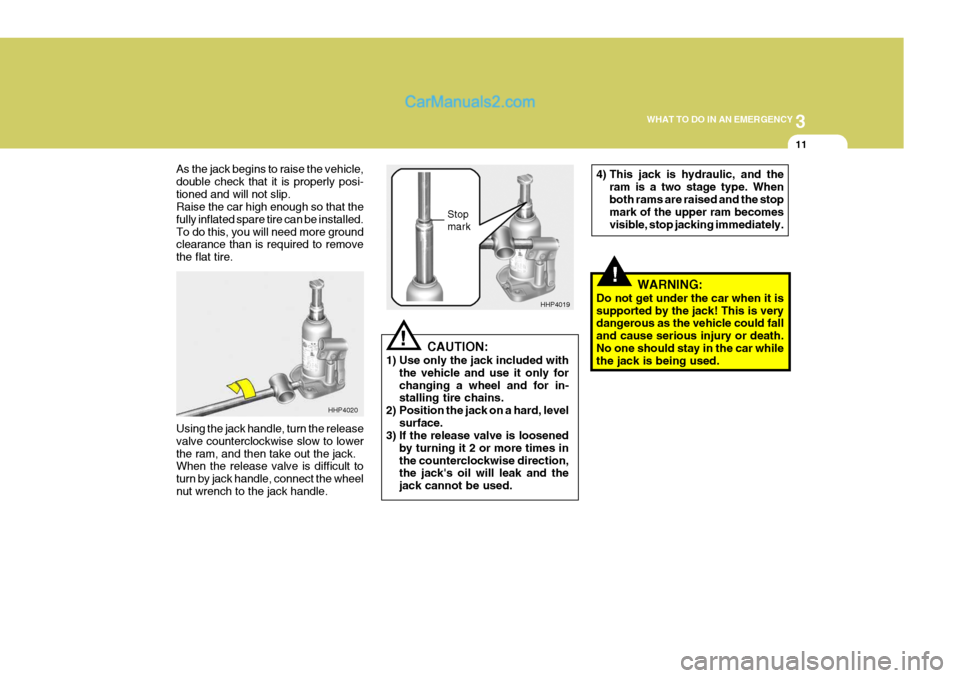2006 Hyundai Terracan spare tire
[x] Cancel search: spare tirePage 185 of 539

2 DRIVING YOUR HYUNDAI
30
!
CAUTION:
The following specifications are recommended when towing a trailer. The loaded trailer weight cannot safely exceed the values inthe following chart. C190E01HP
5. The maximum permissible over-
hang of the coupling point is 1,135 mm.
Gross axle weight
Engine2.5 Load
75 kg
112 kg
75 kg
2.9,3.5E.C only Except E.C
C190E02L
Gross vehicle
weight 3. The front or rear axle weight must
not exceed the Gross Axle Weight Rating (GAWR) shown on the vehicle identification plate (see page 8-2). It is possible that yourtowing package does not exceed the GVWR but exceeds the GAWR. Improper trailer loadingand/or too much luggage in the cargo area can overload the rear axle. Redistribute the load andcheck the axle weight again.
4. The maximum permissible static
vertical load on the coupling de-vice is :
Coupling point
Spare tire
2. The total gross vehicle weight with trailer must not exceed the Gross Vehicle Weight Rating (GVWR) shown on the vehicleidentification plate (see page 8- 2). The total gross vehicle weight is the combined weight of thevehicle, driver, all passengers and their luggage, cargo, hitch, trailer tongue load and other op-tional equipment.
Page 186 of 539

2
DRIVING YOUR HYUNDAI
31
C190F01HP-GAT Trailer or Vehicle Towing Tips
1. Before towing, check hitch and safety chain connections as well as proper operation of the trailer running lights, brake lights, and turn signals.
2. Always drive your vehicle at a mod- erate speed (Less than 100 km/h).
3. Trailer towing requires more fuel than normal conditions.
4. To maintain engine braking effi-
ciency, do not tow a trailer with thetransmission in fifth gear (manual transmission) or an overdrive gear (automatic transmission).
5. Always secure items in the trailer to prevent load shift while driving.
6. Check the condition and air pres- sure of all tires on the trailer and your car. Low tire pressure can seriously affect the handling. Alsocheck the spare tire.
Tongue
75 (165)
112(246)
75(165)
28(61.7)
Engine
2.5
2.5, 2.9, 3.5
!WARNING:
o Improperly loading your car and trailer can seriously affect its steering and braking perfor-mance causing a crash which could cause injury or death.
o When a trailer is used, the opera- tion speed is restricted to 100km/h or less.
With
Brake
Without BrakeE.C only Except E.C
2.9,3.5
Maximum Towable Weight
Trailer
1800(3,968) 2800(6,173) 1800(3,968)
700(1,543)
7. The vehicle/trailer combination is more affected by crosswind and buffeting. When being passed by a large vehicle, keep a constant speed and steer straight ahead. Ifthere is too much wind buffeting slow down to get out of the other vehicle's air turbulence.
8. When parking your car and trailer, especially on a hill, be sure to fol-low all the normal precautions. Turnyour front wheel into the curb, set the parking brake firmly, and put the transmission in 1st or Reverse(manual) or Park (automatic). In addition, place wheel chocks at each of the trailer's tires.
9. If the trailer has electric brakes, start your vehicle and trailer mov-ing, and then apply the trailer brakecontroller by hand to be sure the brakes are working. This lets you check your electrical connection atthe same time.
10. During your trip, check occasion-
ally to be sure that the load issecure, and that the lights and any trailer brakes are still working.
kg.(Lbs)
Page 188 of 539

3
If the Engine Will not Start .......................................... 3-2
Jump Starting .............................................................. 3-3
If the Engine Overheats .............................................. 3-4
Spare Tire .................................................................... 3-5
If You Have a Flat Tire ................................................ 3-7
Changing A Flat Tire ................................................... 3-7
If Your Vehicle Must Be Towed .................................3-14
Emergency Towing .................................................... 3-15
If You Lose Your Keys .............................................. 3-16
WHAT TO DO IN AN EMERGENCY
3
Page 192 of 539

3
WHAT TO DO IN AN EMERGENCY
5SPARE TIRE
!
!!WARNING (Diesel only):
Never work on injection system with engine running or within 30 sec- onds after shutting off engine. High pressure pump, rail, injectors andhigh pressure pipes are subject to high pressure even after the engine stopped. The fuel jet produced byfuel leaks may cause serious in- jury, if it touch the body. People using pacemakers should not movethan 30cm closer to the ECU or wiring harness within the engine room while engine is running, sincethe high currents in the Common Rail system produce considerable magnetic fields. WARNING:
Do not remove the radiator cap whenthe engine is hot. This can allowcoolant to be blown out of the open- ing and cause serious burns.
5. If the water pump drive belt is bro- ken or coolant is leaking out, stop the engine immediately and call the nearest Hyundai dealer for assis- tance. 6. If you cannot find the cause of the
overheating, wait until the enginetemperature has returned to nor-mal. Then, if coolant has been lost, carefully add coolant to the reser- voir (Page 6-12) to bring the fluidlevel in the reservoir up to the half- way mark.
7. Proceed with caution, keeping alert for further signs of overheating. Ifoverheating happens again, call a Hyundai dealer for assistance.
CAUTION:
Serious loss of coolant indicates there is a leak in the cooling system and this should be checked as soonas possible by a Hyundai dealer. D040A01HP-GAT The following instructions for the FULL SIZE spare tire should be observed: Check inflation pressure as soon as possible after installing the spare tire,and adjust to the specified pressure. The tire pressure should be periodi- cally checked and maintained at thespecified pressure while the tire is stored. Spare Tire Pressure
Tire Size Inflation Pressure Full Size 200 kPa (29 psi)
Page 193 of 539

3 WHAT TO DO IN AN EMERGENCY
6
!
D040B03HP-GAT Handling the Spare Tire
1. Obtain the spare wheel rod (Jack
handle) after folding up the seat cushion of the second seat . To fold up the seat cushion, refer to the page 1-25. 2. Insert the spare wheel rod into the
hole in the upper pad of the rearbumper.
3. Connect the wheel nut wrench to
the spare wheel rod.
4. Turn the wheel nut wrench counter- clockwise and the spare tire willlower.
5. Remove the lift plate from the cen- ter of the spare tire after the spare tire is lowered completely. CAUTION:
When installing, turn the wheel nut wrench clockwise till you hear the crackle once or twice(Tightening torque : 3.87 kg.m). And make surethe spare tire is secured in the proper location.
HHP4015
HHP4025 HHP4026Installation is the reverse order of re- moval.
Page 195 of 539

3 WHAT TO DO IN AN EMERGENCY
8
o Remove the spare tire and take out
the jack and tool bag.
NOTE: The spare tire is located underneath the car. D060C01A-AAT 2. Block the Wheel Block the wheel that is diagonally op- posite from the flat tire to keep thevehicle from rolling when the car is raised on the jack.
HHP4011
Flat tireHHP4022
D060B01HP-GAT 1. Obtain Spare Tire and Tool
o Obtain the spare wheel rod (Jack
handle) after folding up the seat cushion of the second seat . To fold up the seat cushion, refer to the page 1-25. HHP4015
Page 198 of 539

3
WHAT TO DO IN AN EMERGENCY
11
!
!
As the jack begins to raise the vehicle, double check that it is properly posi-tioned and will not slip. Raise the car high enough so that the fully inflated spare tire can be installed.To do this, you will need more ground clearance than is required to remove the flat tire. Using the jack handle, turn the release valve counterclockwise slow to lowerthe ram, and then take out the jack. When the release valve is difficult to turn by jack handle, connect the wheelnut wrench to the jack handle. CAUTION:
1) Use only the jack included with the vehicle and use it only forchanging a wheel and for in- stalling tire chains.
2) Position the jack on a hard, level surface.
3) If the release valve is loosened
by turning it 2 or more times in the counterclockwise direction, the jack's oil will leak and the jack cannot be used. Stop mark
HHP4020 HHP4019
WARNING:
Do not get under the car when it is supported by the jack! This is very dangerous as the vehicle could fall and cause serious injury or death.No one should stay in the car while the jack is being used.
4) This jack is hydraulic, and the
ram is a two stage type. When both rams are raised and the stop mark of the upper ram becomes visible, stop jacking immediately.
Page 199 of 539

3 WHAT TO DO IN AN EMERGENCY
12
!WARNING:
Wheel may have sharp edges. Handle them carefully to avoid possible se- vere injury.Before putting the wheel into place, be sure that there is nothing on the hub or wheel (such as mud, tar, gravel,etc.) that interferes with the wheel from fitting solidly against the hub. If there is, remove it. If there is not goodcontact on the mounting surface be- tween the wheel and hub, the wheel nuts could come loose and cause theloss of a wheel. Loss of a wheel may result in loss of control of the vehicle. This may cause serious injury or death. D060H02O-AAT 8. Reinstall Wheel Nuts To reinstall the wheel, hold it on the studs, put the wheel nuts on the studsand tighten them finger tight. The nuts should be installed with their small diameter ends directed inward. Jigglethe tire to be sure it is completely seated, then tighten the nuts as much as possible with your fingers again.
D060G02HP
D060H01HP
D060G02Y-AAT 7. Changing Wheels Use the wrench to loosen the wheel nuts, then remove them with your fin-gers. Slide the wheel off the studs and lay it flat so it cannot roll away. To put the wheel on the hub, pick up the sparetire, line up the holes with the studs and slide the wheel onto them. If this is difficult, tip the wheel slightly and getthe top hole in the wheel lined up with the top stud. Then jiggle the wheel back and forth until the wheel can beslid over the other studs.
D060G01HP